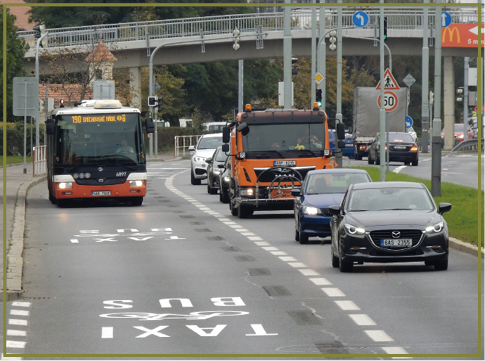8
PRIORITY FOR PUBLIC TRANSPORT VEHICLES
Implementation of priority for public transport vehicles has been ongoing in Prague since the beginning of the 1990s on the basis of the adopted “City of Prague Transport Policy Principles”. This process helps maintain a positive ratio of persons transported by mass transit in relation to individual transport. It also helps keep public transport flowing more smoothly and to uphold transport quality standards.
8.1
Priority for public transport vehicles at traffic signals
New and refurbished traffic signals are now by default equipped with technology that allows the right-of-way to be given to public transport vehicles. These vehicles can thus be the preferred option and have extended green lights adjusted in real time according to their needs so that they can pass through controlled intersections without stopping where possible, or with only a minimum of delay.
The first signal with public transport priority on the tram network appeared in 1993. At the end of 2020, 219 of 247 signals through which trams pass were equipped with some form of tram preference (89 %).
| Traffic signals (TS) with tram priority – basic data |
| Total on tram network |
With tram priority |
With absolute* tram priority |
With conditional* tram priority |
| 247 TS (100,0 %) |
219 TS (89 %) |
67 TS (27 %) |
152 TS (62 %) |
| year 2020: -1 TS |
year 2020: +8 TS |
year 2020: -1 TS |
year 2020: +9 TS |
* Absolut priority means that all trams will pass through the intersection without stopping (except when multiple trams arrive at once); conditional means that the delay and stopping of trams will at least be severely reduced compared to TS without priority.
Traffic signals on tram network

Priority was introduced at another nine already existing traffic signals and the total number of signals with priority thus increased to 219. Absolute priority has now replaced conditional priority at the intersection Plzeňská – Kukulova ramp. In contrast, two traffic signals were modified to only apply conditional preference instead of the original absolute preference.
Bus priority in the form of active detection was put in place at the first pair of intersections in Prague in 2003. At the end of 2019 the total number of traffic signals with active or passive detection had reached 251.
Eight traffic signals were added in 2020 where buses can be given priority using active detection.
The overall number of traffic signals with detection for bus priority thus reached 251.

| Bus priority at traffic signals – basic data |
| With detection for bus priority |
With active* bus detection |
With passive* bus detection |
| 251 TS (100.0 %) |
242 TS (96 %) |
9 TS (4 %) |
| year 2020: +6 TS |
year 2020: +7 TS |
year 2020: -1 TS |
* Passive detection means a bus's claim is recorded through a standard automobile detector (induction loop or video loop), primarily in a dedicated lane. Active detection means a bus logs in and out through radio signal broadcast at defined points from the vehicle to the traffic signal controler. Infrared beacons or GPS are used to locate vehicles approaching the signals.
| Traffic signals equipped with detection for bus priority on bus network |
|
2005 |
2006 |
2007 |
2008 |
2009 |
2010 |
2011 |
2012 |
2013 |
2014 |
2015 |
2016 |
2017 |
2018 |
2019 |
2020 |
| TS with bus detection |
8 |
20 |
54 |
81 |
104 |
121 |
144 |
167 |
180 |
200 |
206 |
223 |
231 |
238 |
245 |
251 |
8.2
Other measures for public transport vehicle priority
An important indicator of the quality of public transport in a city is the degree to which public mass transport is separated from individual transport. For trams, reduction of the number of areas with mixed traffic and an increase in public transport vehicle priority is achieved by constructing tracks on own track bed, potentially also separated from other traffic by concrete dividers (in Prague 52 % of the 142.7 km of tram track is on its own track bed).
Greater fluidity is achieved in bus transport by separate dedicated lanes or buses driving in the tram lane. Priority measures were less needed in 2020 due to lower traffic volumes, nevertheless measures were enacted on the bus network that will help during the expected resurgence of mobility.
Tram priority – raised theresholds along tram tracks
The installation of this element to prevent the frequent cases of cars entering the tram lane proved successful and, starting in 1997, concrete separating thresholds began to pop up in other spots as well.
At the end of 2020, raised concrete dividers along tram tracks had reached a total length of approximately 13 470 metres. Last year around 300 metres of such dividers were added. All the changes in the length of dividers took place during refurbishing of the street Sokolovská.
Bus priority – dedicated lanes
At the end of 2020, the length of dedicated bus lanes had reached approximately 56 000 metres (approx. +7 000 m), with 40 300 metres of that on roads (+5 700 m) and 15 800 on tram track bed (+1 400 m).

New dedicated strip for buses in Modřanská Street
The longest dedicated lane installed last year (reaching almost 900 m) was on Kamýcká heading into the centre. As part of changes to traffic markings on the street 5. května, a new dedicated lane was implemented between the connection from Türkova and the Jižní spojka. Smoother passage of buses is also facilitated by the newly dedicated lanes on the streets Bělohorská from Patočkova to Tomanova, Bohdalecká heading towards U Plynárny, Freyova heading towards the Harfa intersection, Modřanská heading into the centre before Branický most, Novovysočanská heading out of the centre up to the Odlehlá stop, Na Jelenách from Chilská to the Kunratická spojka and Plzeňská between the stops Krematorium Motol and Hlušičkova.
Traffic markings underwent a considerable transformation, including dedicated lanes, on Opatovská.
Buses are now also driving along the tram tracks in segments on Radlická (the 153 line) and at Malostranské náměstí (the 194 line).
In 2020, the first electronic check on compliance with traffic markings was introduced in a dedicated bus lane, on Evropská heading into the centre. The stretch is monitored by a camera system that detects registration plates and automatically evaluates whether the vehicle is authorised.




